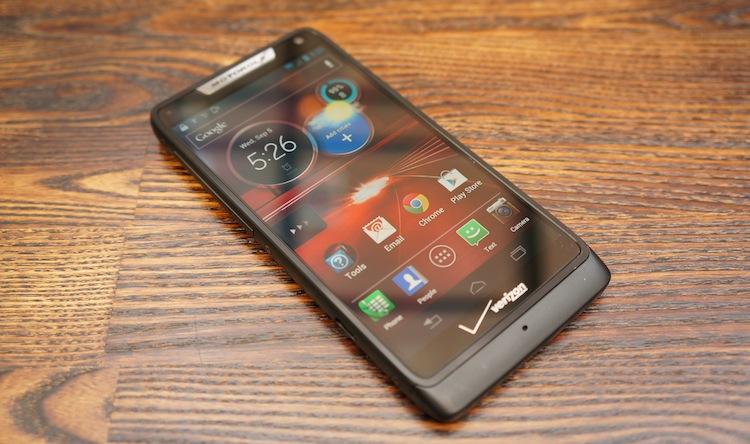
In July, following the Jelly Bean announcement at Google's I/O developer conference, I wrote New Android phones on old software will eventually become a thing of the past. During the opening keynote, Google also announced the new platform development kit, or PDK, for partner manufacturers. Instead of manufacturers not getting their hands dirty in the new Android code until Google releases the source to the public, the PDK means close partners can begin working on the software months before the source code is released.
In theory, this should translate to faster turnaround times on software updates for existing devices and should also mean newer devices will launch on current software, not one or more versions behind. Unfortunately, it seems as if the effects of the PDK are going to take longer to make their way to end users than we would like and Motorola is the bringer of bad news.
Last week, Motorola announced three new phones: the DROID RAZR M, DROID RAZR HD and DROID RAZR MAXX HD. While all the specifications of said phones are on par (or very nearly on par) with their closest counterparts, such as the HTC One X or Samsung Galaxy S III, there was one detail that left us scratching our heads. Instead of these three phones launching withAndroid 4.1, they're coming to market with Ice Cream Sandwich on Motorola's promise of a Jelly Bean update before the end of the year.
In contrast, the HTC One series (and EVO 4G LTE) and all variants of the Samsung Galaxy S III launched before or right after the Android 4.1 announcement in late June. The DROID RAZR M will make its way to market at least two and a half months after the fact. The other two will follow sometime before the holiday season. Do the math. Assuming the DROID RAZR HD and DROID RAZR MAXX HD don't make it to market in late November, that's up to roughly five months after the Jelly Bean announcement and a promise of an update to 4.1 within approximately a month after.
But let's look a bit deeper into this. Samsung is planning the Jelly Bean update to begin rolling out to the Galaxy S III as soon as October. (Realistically, this is more for international customers and U.S. customers to follow. Carrier approval processes here in the States are horrendous and outdated.) The Galaxy Note II is expected to launch in the U.S. sometime this year with Jelly Bean in tow. And I wouldn't be surprised if HTC announces a tentative date for Jelly Bean for its One devices in the next month or so either.
Better yet, Motorola had units at the event last week running Jelly Bean. The ones I managed to push and shove my way to were only fitted with Ice Cream Sandwich, but we know Jelly Bean is up and running on these DROID RAZRs. I can't speak on how smooth or buggy the software is, but Motorola has already put effort into getting Jelly Bean on the phones. And that's very promising. They're even going an extra mile and offering a $100 credit to buyers of Motorola phones that are not in line to receive Jelly Bean.
In the same respect, all of this is a half-hearted effort. Why rush to announce these phones? And why rush their production while only offering consumers the promise of an update that is almost positively going to be delayed and agonizingly slow to arrive. We've been through this several times now. Updates on Android are painful. And promises of updates are a terrible, terrible mistake. If Motorola is going to rush everything else, why not strive to release the devices current software, too?
Most of all, we all are looking to Motorola to set an example, not fall into the same poor habits other OEMs are commonly known for.
While Google swears Motorola Mobility will continue to be run as a separate company, it doesn't take a trained eye to see that Google is already flexing its muscles with its pocket hardware manufacturer. It has installed one of its own, Dennis Woodside, fromer Google Senior Vice President, as CEO of Motorola to replace Sanjay Jha. And the phrases Motorola and Google's Eric Schmidt repetitively used during the announcement last week was "the new Motorola". It was very clear that – despite not wanting to step on its other partners' toes – Google is taking full advantage of now having a hardware company as part of its arsenal.
Because of that, we are looking to Motorola to be the token Android manufacturer, to set the example in hardware, design, software and, most importantly, to prove that keeping Android devices up to date is possible. The PDK will certainly help in due time. But we need a manufacturer to show others the way, and that one has to be Motorola.
Updates and the firmware a phone ships with are two entirely different beasts. I know if I were running a mobile hardware company, the last thing I would want is to have to deal with more post-launch updates than necessary. However, Motorola is dragging their feet and promising what seems to be the impossible – releasing a phone and updating it within the next three months.
Godspeed, Moto. You are now in Google's pocket. Take advantage of that. Differentiate yourself with rapid updates, mostly stock Android phones and consistently releasing new phones with current software. Stop these age-old antics.
What say you, ladies and gentlemen? Should the new DROID RAZRs be equipped with Jelly Bean out of the gate? Or do you think it's okay for devices post-announcement to ship with old software? From a Google-owned company, no less? I think it's foolish. Share your sentiments below.